The content of the article
Allergic cough, paroxysmal and dry. Accompanied by itching throat and nose. Sometimes there is a clear sputum, in which there is no purulent inclusions. Symptoms of allergic cough in a child aggravated in the evening and closer to the night. Some seizures begin suddenly and last 1–2 hours. Only antihistamines can stop them. An allergic cough can turn into bronchitis or asthma if its cause is not corrected in a timely manner.
Home diagnostics
The treatment of any disease begins with a diagnosis. Allergic cough can provoke:
- dust and mites living in down pillows;
- pet hair or saliva;
- feathers of birds;
- household chemicals;
- cosmetics;
- indoor and wild plant pollen;
- Food.
Mom, to determine the cause of pharyngitis, gets a baby diary. She writes in it, with what plants the baby contacted during the walk, what he ate, what he played with and washed his hands. In the diary you need to specify the composition of the dishes, as well as the brand of powder, baby shower gel and other detergents. If there are cats or dogs in the house, the mother records the time when the child came in contact with the animal, and then the baby’s reaction to wool.
The most common food allergens that need attention include:
- citrus fruit;
- honey;
- smoked meat;
- canned food;
- sausages;
- mushrooms;
- eggs;
- exotic vegetables.
If you are unable to determine the cause of the cough yourself, the child is shown a pediatrician and an allergist. Experts give direction to the biochemical and complete blood count, X-ray of the lungs and bronchi. Children from 3 years old do skin tests: put on the forearm several common allergens and monitor the reaction. After identifying the cause, the doctor selects antihistamines that remove cough and other symptoms.
Clean and fresh air
Sometimes experts can not find a source of allergies.In such cases, it is recommended to donate blood and feces for worms. Some parasite infiltrates the lungs and bronchi, causing a dry, spasmodic cough.
In the house where the child is allergic, should be clean. Parents daily wipe dust, clean the floors, regularly vacuum furniture, and refuse carpets. Down pillows and blankets are replaced with options with synthetic fillers. Dirt, dust, sweat and mites do not accumulate in polyester and eco-fiber. Pillows filled with buckwheat husk are also suitable for children.
An ordinary soft toy can provoke an allergy. Plastic machines, dolls and dishes, designers and various board games are bought for the child. But no teddy bears, bunnies and other animals.
Parents are forbidden to smoke in the house and even on the balcony. The smoke and the smell of tobacco, which remains on clothes and seeps into the rooms, can cause spasms in the bronchi and an allergic dry cough.
Pets are regularly bathed, vaccinated and treated for fleas and worms. A child can normally perceive the cat's fur and saliva, but a dirty animal is a source of ticks, worms and infections, which weaken the immune system and make it susceptible to allergens.
Children who have a dry spasmodic cough should not walk near the motorways. Exhaust fumes and dust irritate the nasopharyngeal mucosa and cause tickling. In winter and autumn, you can walk to the park and breathe in the fresh air. In spring and summer, during the period of active flowering, you should avoid the alleys planted with shrubs, trees and ornamental plants.
Cough diet
When exacerbated allergic cough from the diet of the child remove all dangerous products:
- orange vegetables and fruit;
- almonds, hazelnuts, walnuts and peanuts;
- natural cow milk;
- mayonnaise, mustard and ketchup;
- smoked meat and sausages;
- bee products;
- chocolate and sweet baking;
- mushrooms;
- sea fish;
- products containing preservatives.
Contraindicated with duck and goose allergy symptoms. With care, the child is given chicken and turkey breast. Fowl substitute beef or rabbit. Instead of cow's milk, goat is given, but in small quantities.
Green vegetables are allowed: zucchini, broccoli, cucumbers, white cabbage, eggplant, and also porridge. Useful cottage cheese, prunes, bananas and black bread. Can be green apples and boiled potatoes.
Forbidden products are introduced into the child's diet after successful cough treatment. First, give 30 g of mashed pumpkin or red apples, then increase the portion, if the body responds normally to new components.
Products that cause an allergic cough are left on the menu. But they give the child literally 10–15 g of strawberries, mushrooms or milk. Gradually, the body gets used to the component and ceases to produce antibodies.
Cough medicine
Suprastin injection helps to quickly stop the coughing cough. The drug is released in the form of tablets, but they act after 20 minutes. An injection removes allergy symptoms in 5–10 minutes.
Antihistamines are prescribed to children from one month of age. Babies are prescribed "Fenistil" or "Suprastin." Patients from 6 months give a drop of "ketotifen" and "Zyrtec." Children who are 1 year old are prescribed Zodac in liquid form and Erius.
Syringe "Tsetrin" discharged with two years, and pills "ketotifen" - with three. When allergic cough children give "Diazolin", "Loratadin" and "Tavegil."
Between doses of antihistamines, it is recommended to clean the body with sorbents.Polysorb, activated carbon, Enterosgel and Polifan will do. Means relieve coughing attacks, reducing the concentration of allergens in the blood.
Pharmaceutical sorbents are supplemented with seeds or milk thistle oil. The plant cleanses the body of toxins and allergens, soothes sore throat and bronchi, has wound-healing and hepatoprotective properties. Dried seeds are ground into powder and give the child 5 g of the drug twice a day. Thistle oil is used in a similar way. It is impossible to abuse the plant, otherwise the allergic cough will not disappear, but will increase.
Irritation and irritation in the larynx is removed by Glycodine. Syrup softens the mucous membranes of the throat and bronchi, facilitates attacks of dry cough. Children under 7 years old give 5 ml of the drug 4 times a day. In case of an allergy in a schoolchild, the portion is increased to half a teaspoon.
A cough arising from plant pollen or dust is stopped with Levocabastin, Cromohexal or Allergodil sprays. Drugs are prescribed from 6 years. The drug is injected into the nasal passages. It removes swelling, inflammation and tickling. It flushes out particles of pollen and dust.
Allergic cough is treated with antihistamine syrups, pills and sprays. But with complications of the disease, corticosteroids can be prescribed. Hormone therapy restores the bronchi and lungs, protects against asthma.
Immunotherapy
Children from 3–4 years old are given specific immunotherapy. Doctors determine the allergen, and then inject it into the body by injection or oral administration. The method causes the body to get used to the product, causing cough, runny nose and swelling.
The method is recommended if the child’s allergies are due to:
- household chemicals;
- wool, saliva and dandruff of domestic animals;
- mold and fungi living on the walls of the apartment;
- dairy products;
- citruses;
- ambrosia pollen and other plants;
- dust.
Immunotherapy is an expensive and lengthy procedure. Sometimes the treatment is delayed for 3-5 years. But the child gets rid of not only cough, rhinitis, conjunctivitis and other symptoms, but also allergies. The body gradually gets used to citrus or pollen and begins to perceive them neutrally.
The treatment takes place at home. The doctor selects drugs and doses.The first procedure is carried out in the hospital to monitor the reaction of the child's body to the allergen, and then allowed to take the medicine on their own.
Inhalation
A dry cough relieves the nebulizer. The device is intended for inhalation with colds, bronchitis, tracheitis and pharyngitis. The nebulizer is filled with mineral water or saline. The device turns the liquid into steam, which clears the respiratory tract of allergens and moisturizes the mucous membrane, removing tickling.
Mineral water is replaced with special preparations designed to stabilize the mast cell membrane. Children from the age of 6 months are prescribed the pulmonic hormone medication. The drug prevents spasms in the bronchi, removes inflammation and swelling of the respiratory tract. The drug "Pulmicort" diluted with saline. The dosage is selected depending on the age of the child and the neglect of the disease.
Means "Berodual" discharged to patients with dry allergic cough and too viscous sputum. The drug expands the lumen of the bronchi, facilitating breathing, and reduces spasms. "Berodual", as well as "Pulmicort", mixed with saline.
Allergic pharyngitis is treated with Eufillin and Ventolin. The drugs relax the smooth muscles of the bronchi, expanding their lumen. They moisturize the mucous membrane, dilute sputum and gradually reduce the frequency and duration of coughing episodes.
Spasms in the bronchi and lungs removes "Berotek." A 1% solution is poured into the nebulizer, which is prepared from 10 drops of the preparation and 1 liter of liquid. Steam inhalation spend 4 times a day. The procedure can be combined with antihistamine drugs and a special diet that will speed up the recovery of the child.
Massage and breathing exercises
With frequent and prolonged attacks of cough, parents are advised to carry out finger massage. The child lays his stomach on a bed or sofa, hanging his chest down. Mom with one hand holds the feet of the baby, and the second taps on the back in the area of the bronchi and lungs. Fingers move quickly but gently. Gently "run" on the chest of the child, kneading it and removing the spasms. The massage dilutes the sputum and facilitates expectoration, relaxes the smooth muscles of the respiratory system.
Children from 5-6 years old are recommended to do special exercises for allergic cough. Mom can be engaged with the child. Breathing exercises develop the muscles of the chest and bronchi, protect against asthma and calm the nerves.
The technique is simple:
- Mom and baby sit on the mat or just on the floor, close their eyes and listen to their own breathing. They sense how the lungs fill with air and push it out.
- They take a long breath. Bleed air through the nose until there is no free space in the lungs. It is necessary to use the chest and abdomen. Then exhale sharply and quickly through the mouth. Repeat 3-4 times.
- Then the mother and the child take three short breaths, gradually filling the lungs with oxygen. At the expense of "4" sharply exhaled all carbon dioxide. Three repetitions are enough.
- Mom and baby mentally count from 1 to 4 and at this time they take one continuous breath. Air is recruited slowly, working only with the nose. They imagine that oxygen is lowered to the lungs, and then drains to the navel. They hold their breath, counting to eight. If the baby does not work, you can reduce it to 6 or 4, and then gradually increase the number.The air is exhaled on eight bills in short jerks.
Gymnastics can be combined with moderate exercise. Suitable for swimming, rollerblading or cycling. Skates and skis are contraindicated. Before training, the child should drink 150–200 ml of mineral or distilled water. The liquid prevents the accumulation of mucus in the lungs and protects against coughing.
Folk methods
Allergic pharyngitis caused by dust or animal hair is treated with a decoction of bay leaves:
- In 500 ml boil 20 g of spices. The drink is brought to a boil, and after 5 minutes removed.
- Add 25 g of baking soda to the filtered drug.
- The medicine is charged with 30 ml of linden honey.
The child drinks 50–60 ml of medication daily until the seizures cease.
When allergic cough is advised to strengthen the immune system lemon-honey drink:
- Medium-sized citrus is washed, doused with boiling water and passed through a meat grinder, without peeling.
- For 100 g of lemon gruel you will need a glass of lime honey.
- Products are mixed and diluted with 400 ml of distilled water.
- The drink is put in a water bath and heated to 40-50 degrees.
The heat-treated drug is cooled to room temperature and divided into 3–4 servings. The child drinks the remedy for the day, it is possible both before and after the meal.
Important: Lemon-honey drink can not be brought to a boil. At temperatures of +60 degrees and above, the vitamins evaporate and the medicine loses its beneficial properties.
Viscous sputum with allergic cough diluted with camphor oil. The product is heated to 37-39 degrees and rubbed into the chest. Mustard plasters are applied on the right side, they are wrapped on top with food wrap and a thick cloth. Camphor compress hold for 20-30 minutes.
Allergic cough in children is treated with folk and pharmaceutical means, nebulizer and diet. For the prevention of pharyngitis, it is advised to perform breathing exercises, swim a lot, maintain cleanliness in the house and strengthen the child’s immunity by walking in the open air and vitamin complexes.
Video: how to distinguish allergic cough from infectious

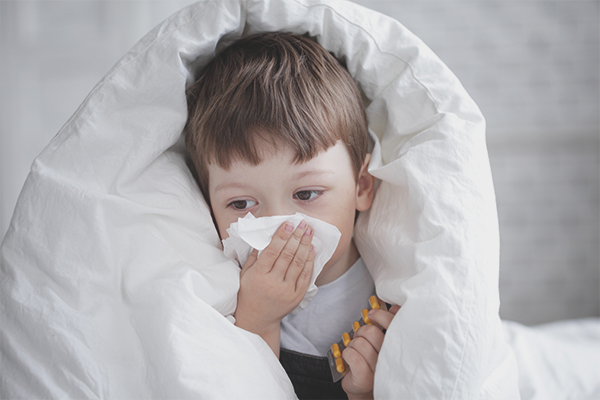
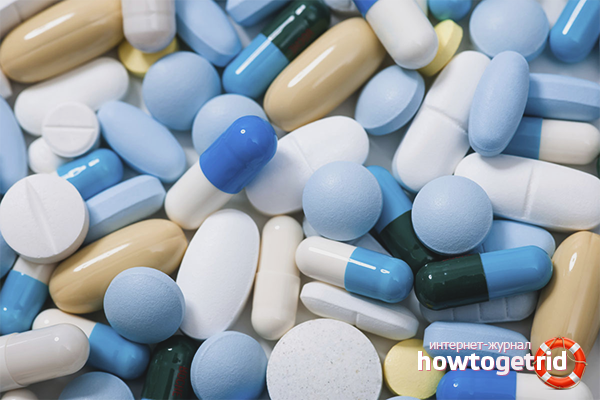
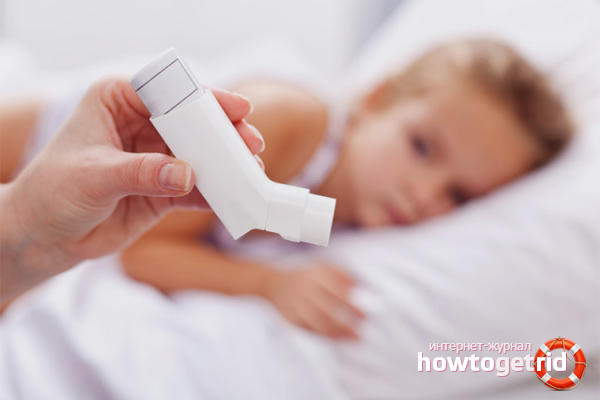


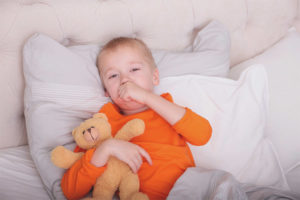
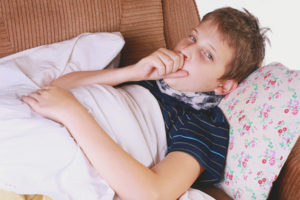
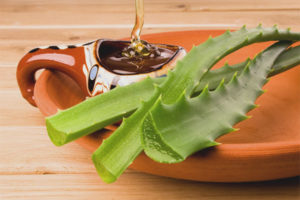
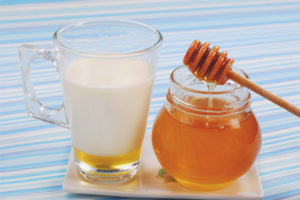

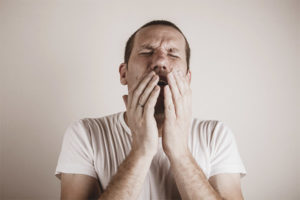
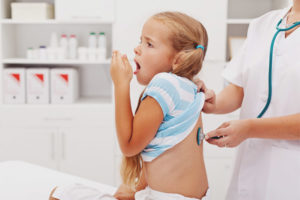

To send